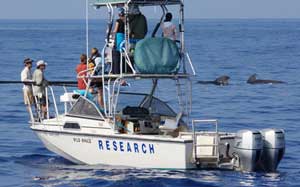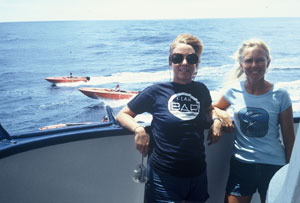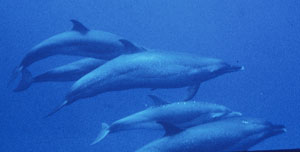For some years now I've been following the work of Robin Baird, PhD, who with colleagues and students has been tracking, tagging, photographing, and counting whales and dolphins around Hawaii for decades. His group, the Cascadia Research Collective, has identified eighteen different species, many of them local residents, and hundreds of individuals. Wow! In my years as head trainer at Sea Life Park in Hawaii we had individuals of thirteen of those species in our tanks. What I wouldn't give to see these rare animals out in the ocean for myself.
This year I planned a family vacation in Hawaii (yes, we went, and yes, it was pure bliss). I also planned to stay a few days longer for a friend's 80th birthday. I e-mailed Robin. Yes, he would be in Hawaii during my free days. Yes, they were going to be going out on the water—twice. Yes, I could join them. Yippee!
Day 1: August 9, 6:00 a.m., Kona, Hawaii
The boat is about 20' long, if that; it's basically a speedboat, with homemade flying bridge and canopy above the cockpit so Dr. Baird can see and run the boat from high above the water surface. The boat is Spartan—no seats, no shade except for the helmsman up on the bridge, no head (bathroom). But it's seaworthy and very fast. There are seven of us aboard: Robin and his two researchers, Jeff and Dan, two guys from Woods Hole with a lot of acoustic gear, an intern, and me. Robin assigns each of us to a station around the ship. From the moment we pass the breakwater, we are all standing at the rail, watching, forward, aft, and to each side, for splashes and dorsal fins in the distance.
We're offshore Kona, travelling fast. It's a little rough out there; this is the deep ocean, so big swells are passing under us. I kind of like being tossed around a little, but it's hard work, too, just keeping your footing. I don't usually get seasick so that part is okay. I brought enough lunch for myself and two or three other people (good thing, it turns out). It's hard to eat a bulky sandwich trying to hold on to the ship with one hand, but it can be done. Turns out if you need to go to the bathroom you can ask for privacy and then crouch on a little platform behind the rear of the boat, where the outboard engines are—awkward but okay.
We have success! On that first day we find and spend time with a school of HUGE pilot whales; these are much bigger than any I've seen in captivity, and quite calm about having us in their midst. One vast mamma with a brand-new calf brings it over to the boat and passes slowly right under the bow pulpit, where I'm standing, as if to show us her baby. I am thrilled; if we see nothing tomorrow I'll still be content with this experience.
Around three o'clock the trade winds pick up. The ocean gets choppy with whitecaps everywhere. You can't spot animals in the distance with the sea kicking up like that, so we go back in. I am so tired I fall asleep for a few moments while getting ready for dinner. "I'm not sure I can do this two days in a row," I think.
But the next morning I'm fine and down at the docks at 6 a.m. ready to go. With sandwiches, water, lots of sunscreen, and the new little video camera Susan Friedman told me to buy.
Day 2: August 10, Kona Hawaii
On this day we locate, join, and spend time with nine different schools of marine mammals and a total of four different species: big Pacific bottlenoses, Stenos (the subject of my creative dolphin paper years ago), more pilot whales, and an animal very familiar to me, the Pan-tropical spotted dolphin, Stenella attenuata.
I love spotters. Small compared to bottlenoses, they are graceful, elegantly marked, prodigious jumpers, and simultaneously timid and courageous. I trained several spotters at Sea Life Park; there are lots of stories in my books about what characters they are.
Thanks to Robin's skilled handling of the boat and expert judgment, we are able to get a good look at a sizeable spotted dolphin school. What I didn't expect or even imagine was that I would get an answer to a research question that has haunted me since 1979.
A bit of my history: spotted dolphins in the tuna boat nets
In 1979, with Ingrid Shallenberger, I did a big research job on dolphins involved in the tuna-porpoise fishery, diving in the net of a tuna fishing boat in the Eastern Tropical Pacific. Most of the animals we studied were spotted dolphins. In the 1960s, fishermen had realized that since dolphins and tuna travel together, by using a huge purse seine you could catch them both, let the dolphins out over the rim of the net, and keep the tuna.
Initially, handling the net was a problem and many dolphins were killed. By 1979 things had improved. The boat we were on was expert. No dolphins were killed or injured. The animals were experienced, too. They were often very calm in the net, and knew how to be let out safely at the end. The vessel successfully "set" the net around schools of dolphins and tuna on more than 20 occasions during our trip. We dove in 17 different sets of the net. The dolphins usually didn't mind us. If they were resting on the surface we could swim among them and even touch them,
From the surface, dolphins in the net seemed to be one big school. Looking underwater, we could see that spotters were sometimes divided into two or more separate schools, each carefully maintaining a distance from the others. The behavior of the animals suggested to us that the animals in a given school knew each other and were probably related. The fact that they distanced themselves from the strangers in some other school corroborated completely with what Ingrid and I had seen in captivity: jokingly we called these dolphins terrible snobs.
The resulting monograph from our research project, a government publication, tells quite a lot about the highly organized nature of the individual schools. Each school we saw in the net was itself made up of separate subgroups, consisting of mother-baby pairs, mother-young subgroups with older calves, large, untidy groups of young adults squabbling and flirting among themselves, and groups of four or more dominant senior males swimming in precise formation like performing jet planes. Some schools, but not all, also had special juvenile sub-groups, six or so animals, three-quarter size but acting just like the dominant males and in the same precise formations.
We had the photos and the data. Even so, skeptics pointed out that all of our data came from animals confined in a huge net. That was surely unnatural, so much so that what they actually do in the ocean might be very different. For that, Ingrid and I had no answer but a shrug. Maybe so.
Spotted dolphins off the Kona Coast
We are way off shore now; the top of Mauna Kea, the big volcano behind the little town of Kona, is lost in clouds. Below the clouds is a thick layer of hazy volcanic smog ("vog"); the island is almost invisible. We spot splashes in the distance, a few birds overhead, and two fishing boats stationary on the edges of the disturbed area. It's a school of spotted dolphins, probably feeding; we join the party. I'm guessing, by the size of the area that there are 200 animals. It's impossible to count accurately from the surface. I would love the chance to take one look underwater, and I brought my mask and fins, but it's pretty sharky out here and other people have other scientific tasks with priority, so I'm not going to ask.
Spotters enjoy bow-riding, so as we motor slowly among them they join us. Looking down into the water, I can see mother-baby pairs, a mother-young subgroup with assorted sizes of young (the loose lively mix suggesting young adults), and, yes, here beside the boat, a pair of senior males with their flashing white nose tips and dark mask and backs. Wait—right next to them, spaced as evenly as fighter planes, they are joined by four more. It is a senior male squad in perfect formation, just as we saw them in the nets but wider apart. Makes sense; they have more room here.
As we're watching the school, I'm chatting with Max, an MIT grad student who is one of the Woods Hole guys. Fishermen have described to me how sometimes spotted dolphins do a spectacular leap, straight up in the air, body at an angle. Scientists call this a "display behavior." I've never seen it personally, not at Sea Life Park and not in the Eastern Tropical Pacific. I tell Max to watch for that spotter leap.
Now Jeff, one of the Cascadia team members, has captured the dorsal fin photos they need. These photos will be compared with 20 years worth of additional photos to help identify this particular school. It's time to move on. We start up at full speed again. Our sharp prow and two powerful engines make a big wake.
I look back. Oh, look! Six little spotters are surfing in that wave we are making. Max and I are enjoying that sight—and I am thrilled. These six animals, spaced out with military precision and three-quarter size (bigger ones are right next to them, so I'm not imagining that), look like a juvenile subgroup to me. That's the final confirmation for me. Thousands of miles away and almost thirty years later, I know that spotted dolphins do what they do: they live in five kinds of subgroups. What we saw in the nets was what we have in the ocean. We did not make it up.
I start the camera and point it at the wake. Just then, in front of the wave, an excited young adult spotter performs the sensational spotted dolphin display leap. Twice. I got it on camera. You can hear me and Max cheering.
As the school falls behind, the guys up on the flying bridge must think I'm crazy, because I'm dancing up and down and blowing kisses to the animals. Aloha nui loa, dear spotters. It was wonderful to see you again.
Karen Pryor
Read more of Karen's spotter stories in Lads before the Wind and Reaching the Animal Mind.
Read more about Robin Baird and colleagues, including Hawaiian odontocetes overview, summary, funding, research reports, opportunities, publications, and photos, at the Cascadia Research Collective website.
Go whale and dolphin watching with Dan McSweeney in Kona, Hawaii in the fall and winter.






Post new comment